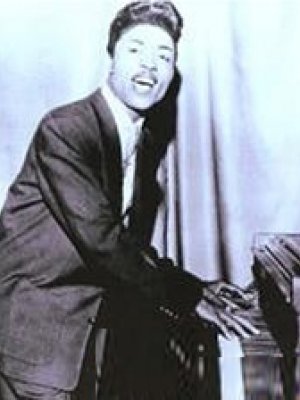

But by the autumn of 1955 he was still mostly a Deep South sensation, and when he entered Cosimo Matassa's famous J&M Studios in New Orleans with producer Bumps Blackwell nothing was working. Unsurprisingly given the company he was keeping, Richard developed a wild act on the road and made a bunch of relatively successful rhythm and blues sides for labels like Peacock and RCA-Victor. His early life as an entertainer included tours with drag queens, minstrel shows and girls who would, as he said to his biographer Charles White in the early 1980s, "roll their bellies and stuff" – Little Egypt's granddaughters carrying exotica into the nuclear age. When a band touring through the South picked him up as a singer, his father finally granted approval of Richard's pompadour hairstyle – because that's how artists looked, after all. Inspired by gospel music and jump blues, he developed a vocal style that was, above all, loud. Richard Penniman was uncontainable from the beginning of his life in Macon, Ga., a little queer boy whose penchant for dressing "beautiful" scared his father but whose precocious piano playing saved him from utter marginalization or an even worse fate. All of them had the same basic mandate – to turn fearful feelings into fun. Elvis came off as wiser than Holly and more innocent than Little Richard. Buddy Holly's singing embodied desire in formation: thoughts that seem unspeakable because they've never been spoken before. Little Richard represented what happens to unspeakable desires after they've been dug out of the dirt where society buried them. The Memphis King claimed the middle ground between his rivals' two extremes: the strategic outrageousness of Richard Wayne Penniman, the original Black Weirdo, bursting every seam apparently for the hell of it, but really as a way of sharing subterranean secrets of two centuries' worth of racial and sexual nonconformists and the shy, bespectacled Charles Hardin Holley, archetypal White Nerd, stumbling over his words and music as a way of pushing them into shape. , written by NPR Music's critic and correspondent Ann Powers and published by Dey Street Books in 2017.Įlvis's two greatest contemporaries were Little Richard and Buddy Holly, each standing at either end of the spectrum upon which nonsense flourished. This essay was originally published as part of the bookGood Booty: Love and Sex, Black and White, Body and Soul in American Music Verlaine on Ask Greil 2022 [update: Oct.Little Richard died on Saturday, in Tullahoma, Tenn.

Top 10 Jeff Porcaro… on Warren Zevon, ‘Excitable… Long Live The King (… on The Building Has Left Elvis: P… Sebastian on The Whole World in a Song (Int…īill Pullman: From C… on Bill Pullman’s Face…

(Chicago) on Ask Greil 2022 [update: Oct.…īruce Allen on Ask Greil 2022 [update: Oct.… He was having sex with Angel, I was jacking off, and Angel was sucking me, when they introduced his name on stage!… He came and he went!” There’s wonder in that story (told well after Richard most recently gave up the Devil’s music for the Lord’s work) what one takes away from this book is a sense of how inevitable it was that the Black Liberace would tell everyone in the world all about it-in ” Tutti Frutti,“ in “I Don’t Know What You Got (But It’s Got Me),” in “Keep A-Knockin’.” British rock fanatic, physician, and DJ Charles White balances recording-session detail with orgies after a while you can’t tell one from the other. He was ready, so she opened her legs and he put it in her. Conventional scandal-bios or tell-alls pale in comparison: “One time we were playing at the Paramount Theater and Buddy came into my dressing room while I was jacking off with Angel sucking my titty… Buddy took out his thing. What’s this about “The Quasar of Rock”? Little Richard was always the Queen of Rock-as this deft assembly of taped interviews with those who knew, mostly Little Richard himself, makes abundantly clear.


 0 kommentar(er)
0 kommentar(er)
